Selina Concise Biology Class 10 ICSE Solutions Chapter 1 - Cell Cycle, Cell Division and Structure of Chromosomes
Selina Concise Biology Class 10 ICSE Solutions Cell Cycle, Cell Division and Structure of Chromosomes
Selina Concise Biology Class 10 ICSE Solutions Cell Cycle, Cell Division and Structure of Chromosomes
Exercise 1.1
A.1.The chromatin material is formed of
(a) DNA only
(b) DNA and Histones
(c) Histones only
(d) Nucleotides
(a) DNA only
(b) DNA and Histones
(c) Histones only
(d) Nucleotides
(b) DNA and Histones
A.2.The term “chromosomes” literally means
(a) Inherited bodies
(b) Twisted threads
(c) Coloured bodies
(d) Shining threads
Solution A.2.
(c) Coloured bodies
B.1.Name the following:
(a) The repeating components of each DNA strand lengthwise.
(b) The complex structure consisting of DNA strand and a core of histones.
(c) The type of bond which joins the complementary nitrogenous bases.
(d) The three components of nucleotide.
Solution B.1.
(a) – Nucleotides.
(b) – Nucleosome.
(c) – Hydrogen Bond.
(d) – Phosphate, Sugar and Nitrogenous base.
C.1.What is the difference between chromatin fibre and chromosome?
Solution C.1.
Chromatin fibre is unfolded, uncondensed, extended DNA. It is only visible when cell under goes division whereas chromosomes are condensed DNA and they are visible when the cell is divided.
C.2.What are the rungs of the "DNA ladder" made of?
Solution C.2.
Rungs of DNA ladder is made of nitrogenous bases which includes Adenine (A), Guanine (G), Cytosine (C) and Thymine (T).
C.3.Correct the following statements if there is any mistake.
(a) The four nitrogenous bases in the DNA are Guanine, Thiamine, Adrenaline and Cytosine.
(b) Genes are specific sequences of bases on a chromosome.
(c) A nucleotide is composed of a sulphate, a sugar (pentose) and a nitrogenous base.
(d) Nucleosomes are groups of cysteine molecules surrounded by DNA strands.
(e) If there are 46 chromosomes in a cell there will be 23 chromatin fibres inside the nucleus during interphase.
Solution C.3.
(a) The four nitrogenous bases in the DNA ladder are Guanine, Thymine, Adenine and Cytosine.
(b) Genes are specific sequences of nucleotides on a chromosome.
(c) A nucleotide is composed of a phosphate, sugar (pentose) and a nitrogenous base.
(d) Nucleosomes are groups of histone molecules surrounded by DNA strands.
(e) If there are 46 chromosomes in a cell there will be 46 chromatin fibres inside the nucleus during interphase.
D.1.
Solution D.1.
Nucleosome is basic structural unit of DNA. Each strand of DNA winds around a core of eight histone molecules. This core can be imagined like a football, around which a long rope is wound with one or two loops. Each such complex structure is called a nucleosome. A single human chromosome may have about a million nucleosomes.
D.2.What are genes?
D.2.What are genes?
Solution D.2.
Gene is a structural and functional unit of heredity and variations. Genes are specific sequences of nucleotides on a chromosome that encode particular proteins which express in the form of some particular feature of the body. In other words, gene is the DNA segment of the chromosome and it controls the expression of characteristics.
E.1.Given below is a schematic diagram of a portion of DNA.
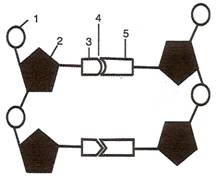
(a) How many strands are shown in the diagram?
(b) How many nucleotides have been shown in each strand?
(c) Name the parts numbered 1,2,3,4 and 5 respectively.
(d) Name the DNA unit constituted by the parts 1, 2 and 3 collectively.
E.1.Given below is a schematic diagram of a portion of DNA.

(a) How many strands are shown in the diagram?
(b) How many nucleotides have been shown in each strand?
(c) Name the parts numbered 1,2,3,4 and 5 respectively.
(d) Name the DNA unit constituted by the parts 1, 2 and 3 collectively.
Solution E.1.
(a) 2
(b) 2 on each strand
(c) 1- Phosphate, 2- Sugar, 3- Bases, 4- Hydrogen Bond, 5 – Base
(d) Nucleotide
E.2.The three sketches given below (A, B and C) are intended to represent the replication of DNA. What should be their correct sequence starting with the first and ending with the last? ...........

Solution E.2.
B, C and A.
Exercise 1.2
A.1.The number of chromosomes in a certain type of cell division is halved. This kind of cell division occurs in
(a) only testis
(b) only ovary
(c) both ovary and testis
(d) all body cells
(c) both ovary and testis
A.2.In which one of the following options the two stages of mitosis have been given in correct sequence?
(a) Prophase, metaphase, telophase, anaphase
(b) Prophase, metaphase, anaphase, telophase
(c) Anaphase, telophase, prophase, metaphase
(d) Telophase, anaphase, prophase, metaphase
Solution A.2.
(c) Anaphase, telophase ,prophase, metaphase
A.3.Synthesis phase in the cell cycle is called so for the synthesis of more of
(a) RNA
(b) RNA and proteins
(c) DNA
(d) Glucose
Solution A.3.
(c) DNA
B.1.Imagine one cell (A) has undergone one mitotic division and another cell (B) has completed its meiotic division. How many cells would the two produce?
Cell A: ............................
Cell B:.............................
Solution B.1.
Cell A: 2
Cell B: 4
B.2.
Column 'A'
|
Column 'B'
|
(a) Chromosomes become arranged in a horizontal plane at the equator.
(b) Daughter chromosomes move to the opposite poles of a spindle
(c) Chromosomes become visible as fine long threads.
(d) Chromosomes lose their distinctiveness and gradually become transformed into a chromatin network
|
Anaphase
Prophase
Telophase
Metaphase
|
Solution B.2.
(a) – Metaphase.
(b) – Telophase.
(c) – Prophase.
(d) – Anaphase.
B.3.
Solution B.3.
(a) Somatic (body).
(b) Four.
(c) Reproductive.
(d) 23 and 23.
(e) Haploid.
(f) Centriole.
C.1.State the difference between:
(a) Chromosome and chromatid,
(b) Centrosome and centomere,
(c) Aster and spindle fibres
(d) Haploid and diploid
Solution C.1.
(a) A chromosome is an organized structure of DNA and protein found in cells. It is a single piece of coiled DNA containing many genes, regulatory elements and other nucleotide sequences whereas a chromatid is one of the two copies of DNA making up a duplicated chromosome, which are joined at their centromeres, for the process of cell division (mitosis or meiosis).
(b) The centrosome is an area in the cell where microtubules are produced. Within an animal cell centrosome, there is a pair of small organelles called the centrioles. During animal cell division, the centrosome divides and the centrioles replicate (make new copies) whereas each chromosome in its condensed form consists of two chromatids joined at some point along the length. This point of attachment is called centromere.
(c) An aster is a cellular structure shaped like a star, formed around each centrosome during mitosis in an animal cell whereas spindle fibers are aggregates of microtubules that move chromosomes during cell division.
(d) A haploid cell is a cell that contains one complete set of chromosomes. Gametes are haploid cells that are produced by meiosis whereas a diploid cell is a cell that contains two sets of chromosomes. One set of chromosomes is donated from each parent.
C.2."First meiotic division is the reduction division". What does the word 'reduction' refer to in this statement?
C.2."First meiotic division is the reduction division". What does the word 'reduction' refer to in this statement?
Solution C.2.
In this statement, reduction means that the number of chromosomes are reduced to half i.e. out of the 23 pairs of chromosomes in humans, only single set of chromosomes are passed on to the sex cells.
C.3."Gametes must be produced by meiosis for sexual reproduction". Why is it so?
C.3."Gametes must be produced by meiosis for sexual reproduction". Why is it so?
Solution C.3.
Gametes must be produced by meiosis for sexual reproduction because the numbers of chromosomes are reduced to half during meiosis and then the normal diploid numbers of chromosomes are regained during the process of fertilization.
C.4.Mention whether the following statements are true (T) or false (F). Give reason in support of your answer.
(a) As you grow from childhood to adult hood, your skin cells divide only to replace such cells that are lost from the surface.
(b) The unfertilized human egg has half the number of chromosomes of the body cells.
(c) Nuclear membrane in a mitotically dividing cell remains intact up to the metaphase and disappears only in the telophase.
(d) Mitotic cell division can be a mode of reproduction.
(e) Crossing-over between chromatids can occur only between homologous chromosomes.
C.4.Mention whether the following statements are true (T) or false (F). Give reason in support of your answer.
(a) As you grow from childhood to adult hood, your skin cells divide only to replace such cells that are lost from the surface.
(b) The unfertilized human egg has half the number of chromosomes of the body cells.
(c) Nuclear membrane in a mitotically dividing cell remains intact up to the metaphase and disappears only in the telophase.
(d) Mitotic cell division can be a mode of reproduction.
(e) Crossing-over between chromatids can occur only between homologous chromosomes.
Solution C.4.
(a) F; Surface skin cells are continuously lost and replaced by the underlying cells.
(b) T; All types of human cells, have 46 chromosomes. The only type of cell which does not have 46 chromosomes are the sex cells, which have only half of the number, so they have 23 chromosomes. The egg cell is a sex cell (found in female). So it must have 23 chromosomes.
(c) F; Nuclear membrane disappears in Prophase itself, however it reappears during Telophase.
(d) T; Mitotic cell division can be a mode of asexual reproduction in unicellular organisms like amoeba or yeast cell which divides into two daughter cells.
(e) T; While the maternal and paternal chromosomes are separating, the chromatid material gets exchanged between the two members of a homologous pair resulting in genetic recombination.
D.1.The diagram below represents a stage during cell division. Study the same and then answer the questions that follow:

a. Name the parts labelled 1, 2 and 3.
b. Identify the above stage and give a reason to support your answer.
c. Mention where in the body this type of cell division occurs.
d. Name the stage prior to this stage and draw a diagram to represent the same.
D.1.The diagram below represents a stage during cell division. Study the same and then answer the questions that follow:

a. Name the parts labelled 1, 2 and 3.
b. Identify the above stage and give a reason to support your answer.
c. Mention where in the body this type of cell division occurs.
d. Name the stage prior to this stage and draw a diagram to represent the same.
Solution D.1.
a.
- Centromere
- Spindle fibres
- Chromatids
b. The stage described in the diagram is the late anaphase of mitosis in an animal cell. The stage can be identified by the presence of separated chromatids which are found at the two poles of the cell. The appearance of the furrow in the cell membrane classifies the stage as the late anaphase.
c. The division is mitotic division and this kind of cell division occurs in all the cells of the body except for the reproductive cells.
D.2.Draw a labelled diagram to show the metaphase stage of mitosis in an animal cell having '6' chromosomes.
D.3.The diagram given below represents a certain phenomenon which occurs during meiosis.
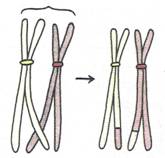
Name and explain the phenomenon by using the terms - homologous chromosomes, chromatids, and crossing-over.
The exchange of chromatids between homologous chromosomes is called crossing-over. This is the process by which the two chromosomes of a homologous pair exchange equal segments with each other.
Crossing over occurs in the first division of meiosis. At that stage each chromosome has replicated into two strands called sister chromatids. The two homologous chromosomes of a pair synapse, or come together. While the chromosomes are synapsed, breaks occur at corresponding points in two of the non-sister chromatids, i.e., in one chromatid of each chromosome.
Since the chromosomes are homologous, breaks at corresponding points mean that the segments that are broken off contain corresponding genes, i.e., alleles. The broken sections are then exchanged between the chromosomes to form complete new units, and each new recombined chromosome of the pair can go to a different daughter sex cell. It results in recombination of genes found on the same chromosome, called linked genes that would otherwise always be transmitted together.
D.4.Given below is a diagram representing a stage during mitotic cell division in an animal cell. Examine it carefully and answer the questions which follow.
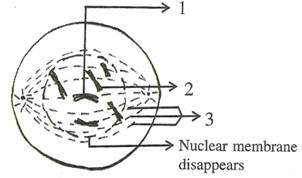
(a)Identify the stage. Give one reason in support of your answer.
(b) Name the cell organelle that forms the 'aster'.
(c) Name the parts labelled 1, 2 and 3.
(d) Name the stage that follows the one shown here. How is that stage identified?
(e) Mention two points of difference between mitosis and meiosis with regard to:
(i) The number of daughter cells produced.
(ii)The chromosome number in the daughter cells.
D.4.Given below is a diagram representing a stage during mitotic cell division in an animal cell. Examine it carefully and answer the questions which follow.

(a)Identify the stage. Give one reason in support of your answer.
(b) Name the cell organelle that forms the 'aster'.
(c) Name the parts labelled 1, 2 and 3.
(d) Name the stage that follows the one shown here. How is that stage identified?
(e) Mention two points of difference between mitosis and meiosis with regard to:
(i) The number of daughter cells produced.
(ii)The chromosome number in the daughter cells.
Solution D.4.
(a) Late prophase. Because the nuclear membrane and nucleolus have disappeared.
(b) Centrioles.
(c)
- Centromere
- Chromatids.
- Spindle fibre.
(d) Metaphase. The centromeres of chromosomes are drawn to the equator by equal pull of two chromosomal spindle fibres that connects each centromere to the opposite poles, forming a metaphasic plate.
(e)
D.5.Given ahead are three diagrammatic sketches (A, B and C) of one and the same particular phase during mitotic type of cell division.
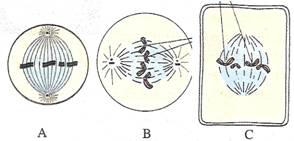
(a) Identify the phase ..............
(b) What is the diploid number of chromosomes shown in them? ................
(c) Identify whether these are animal cells or plant cell? Give reasons.
A .................
B .................
C .................
Solution D.5.
(a) Metaphase.
(b) 4.
(c)
A – Animal
B – Animal
C – Plant
(d) (iv)
D.6.Shown below are four stages (A, B, C, D) (not in sequence) of a certain kind of cell division.
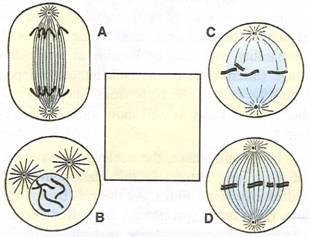
(a) Is it a plant cell or an animal cell? Give two reasons .............
(b) Is it undergoing mitosis or meiosis? ..................
(c) What should be the correct sequence of these four stages among themselves? ..................
(d) Name the stage that should precede the earliest of these stages..............
(e) Draw the stage named above inside the blank space provided.
Solution D.6.
(a) This is an animal cell because:
- The outline is circular (in plants it would be angular {rectangular or polygonal}) and cell wall is absent.
- Centrosomes on centrioles are present. (These are found only in animal cells)
(b) Mitosis.
(c) B, C, D, A.
(d) Interphase.
(e)
Selina Concise Biology Class 10 ICSE Solutions Cell Cycle, Cell Division and Structure of Chromosomes | Selina Concise Biology Class 10 ICSE Solutions Cell Cycle, Cell Division and Structure of Chromosomes



